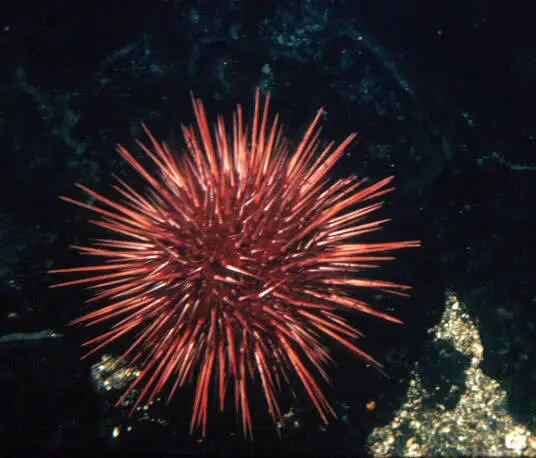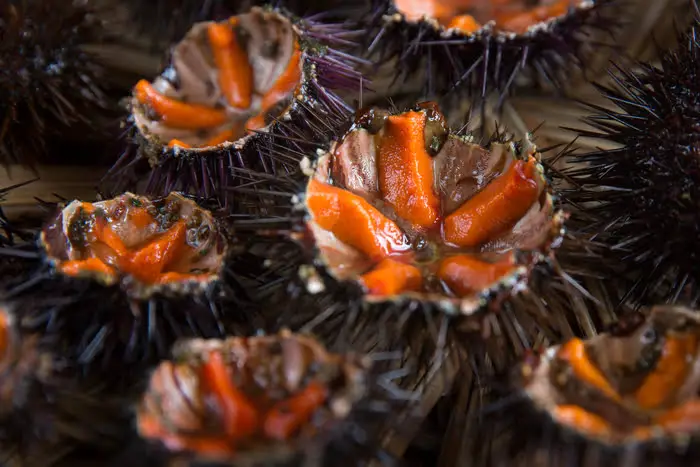Americans’ love of seafood brings us into contact with animals of all shapes and sizes, from fish, to crustaceans, to shellfish.
But one critter you may not have thought of as food is the humble sea urchin.
Not only are these spiky animals edible, but some areas consider them a delicacy, but eating them could also offer the potential to benefit the environment!
So put on some thick gloves, because we’re taking a tender look at the delicious and sustainable meal beneath the spines.
Table of Contents
- What Parts of the Sea Urchin are Edible?
- What Kinds of Urchins are Eaten?
- How Does Sea Urchin Look and Taste?
- Where is Sea Urchin Eaten?
- How is Sea Urchin Served?
- Why is Sea Urchin So Expensive?
- A Dangerous Delicacy: Urchins Out of Control
- Can Eating Urchins Save the Environment?
- Conclusion
What Parts of the Sea Urchin are Edible?
Taking a look at an urchin, it isn’t obvious that they can be eaten at all. But beneath their sharp spines and hard shell, sea urchins hide a tasty surprise in the form of their gonads!
Called uni in Japanese, this soft, supple food is often mistakenly marketed as sea urchin eggs. In reality, uni is the urchin’s reproductive organ.
Don’t let this fact make you squeamish, however- uni is known as one of the most luxurious seafood options available, right up there with caviar!
Sea urchins are members of the echinoderm family, just like starfish and sand dollars, and these animals are known for having five-fold radial symmetry.
As a result, uni grows in five distinct ‘tongues’ within the urchin. It’s like there’s a delectable little star inside of every urchin!
What Kinds of Urchins are Eaten?
It depends on where you live, as many different species of urchins are harvested in different regions.

The most commonly farmed urchin species in the US are red sea urchins (Mesocentrotus franciscanus) on the west coast, and green sea urchins (Strongylocentrotus droebachiensis) on the east coast.
Japanese uni comes mainly from an urchin called bafun (Hemicentrous pulcheririmus) and another called murasaki (Heliocidaris crassispina). Bafun uni is considered to have a more complex flavor while murasaki is considered more beginner-friendly.
How Does Sea Urchin Look and Taste?
Fresh uni is bright orange, with a soft and creamy texture similar to pâté. It holds its shape, but is soft enough to spread with a knife like a jelly or jam.
Many people have described the taste of uni in different ways, but the major notes people can agree on are that it packs a strong umami kick, with a hint of the salty oceanic flavor common to most seafood.
The highest quality uni takes on a slightly sweet taste in addition to the umami and salt flavors, and is firmer than lower-grade product.

In short, think of it as a sweet, briny, fresh seafood cream. These odd looking animals are truly delicious underneath!
Related: Can You Eat Barnacles? (Is It Even Possible?)
Where is Sea Urchin Eaten?
The majority of uni is consumed in Japan, which may not come as a surprise due to the fact that most of the world calls the dish by its Japanese name.
But uni is slowly taking off in other regions of the world too, especially in recent years!
Almost any region with a coastline hosts some population of sea urchins that can be harvested from the wild.
In particular, Chile, the US, and the Mediterranean Sea region have all started consuming more uni in recent years. It seems urchins are starting to take off!
How is Sea Urchin Served?
The traditional method of serving uni is, unsurprisingly, in sushi! Raw uni can be enjoyed by itself draped over sushi rice, or draped over the top of a sushi roll to add a subtle accent to the other flavors.
Many other traditional Japanese dishes can also be topped with uni to add a decadent topping.
Other regions have started to craft their own unique urchin recipes as well! Cooked uni is showing up more and more often as a topping or side to high-end seafood dishes.
Uni has been used more recently as an ingredient in pasta sauce, flavored butter, and even in experimental flavors of ice cream!
Why is Sea Urchin So Expensive?
A quick online search for uni will show staggering prices of between $20 and $30 for a single ounce.
The most expensive uni can sell for up to $400 per kilogram at bulk prices. Despite how common these animals are, the processed uni is extremely pricey!
The reason for this is because urchins are never farmed, and only ever wild caught. Specially trained urchin divers are paid to swim out into the ocean and pick up mature urchins for sale.
Processing the urchins also takes time and precision, and both of these things can seriously jack up prices!
A Dangerous Delicacy: Urchins Out of Control
Despite their innocent appearance, urchins can be a serious problem when the ecological balance is upset.
When natural urchin predators such as sea otters are removed from the environment, urchins can spread unchecked, eating up entire swaths of kelp forest habitat.
The resulting environment is called an urchin barren and offers a far poorer quality habitat for many species.
The worst part is that the urchins aren’t even marketable! They reproduce so quickly that every single one is essentially starving. They can survive this food shortage, but their gonads are so small that they simply aren’t worth collecting.
Scientists, however, are brainstorming solutions to this problem that can benefit the environment and foodies alike.
Can Eating Urchins Save the Environment?
According to science, it could certainly help.
Researchers across the world are experimenting with harvesting these small, starving urchins en masse from barrens to ‘fatten’ them up over a few months in tanks.
The urchins, being fed farmed seaweed, can grow their gonads out to their full potential before being processed.

This solution has the potential to offer jobs for urchin diver and open up a whole new industry of urchin rearing farms, all while allowing kelp forests to recover in the urchins’ absence. A rare case of a true win-win for both humans and the environment!
There are a countless number of starved urchins out there, so if scaled up, these farms could drive the price of uni down as well, serving as an additional bonus for foodies.
Conclusion
Sea urchins are starting to be recognized and respected in the US for the delicious treats they are, right up there with lobster, oyster, and all the rest.
And with urchins threatening sensitive kelp forest habitat around the world, removing them for farming can provide a delicious and effective way to restore it.
So if your stomach is feeling adventurous, consider these scrumptious balls of spikes. Thanks for reading!
See Also: What Is The Best Tasting Fish? FULL Species List Ranked!

Growing up in Florida, I’ve been surrounded by saltwater my entire life…and I love sharing my passion with others.
To learn more about why I started Saltwater Mecca, visit the ABOUT page.
Thank you for reading this article. Browse around & have some fun!